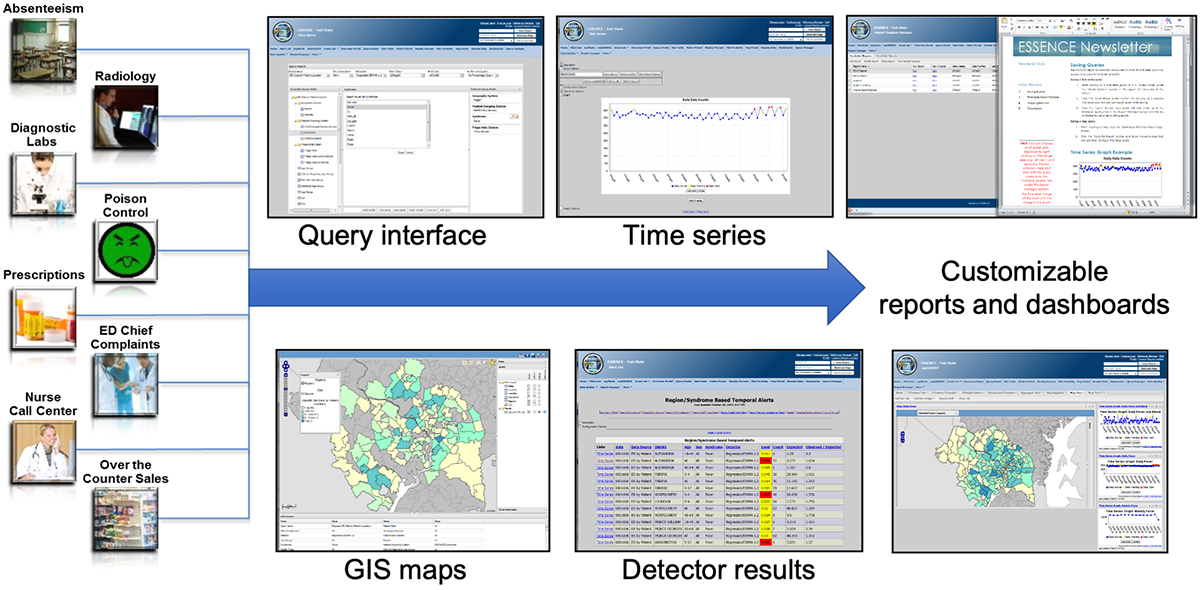Injury and Violence Prevention
- Injury and Violence Prevention Home
- Data Projects
- MIDAS: Minnesota Interactive Data Access System
- Publications
Related Topics
Injury and Violence Prevention Syndromic Surveillance
Syndromic surveillance emphasizes the use of near real-time data with statistical tools to detect and characterize unusual activity for further public health investigation.
Syndromic surveillance systems may be utilized for situational awareness, to further characterize an outbreak beyond initial detection, to monitor the spread of an outbreak, and/or to monitor the effectiveness of outbreak response and interventions. These data help public health officials detect, monitor, and respond quickly to local public health events of importance.
Benefits of Using and Interpreting Syndromic Surveillance Data
Syndromic surveillance differs from other data sources, such as electronic case reports, All Payer Claims Database (APCD), and Electronic Health Record (EHR) Consortium data, in the breadth of data collected resulting in the ability to monitor and identify emerging public health concerns in near-real time. Syndromic Surveillance includes data on all visits treated at hospitals, regardless of condition. Analysis of these data based on signs and symptoms before a confirmed diagnosis or lab test significantly improves the timeliness of analysis and allows identification of concerns across a broad range of conditions. Other data sources are focused on a specific diagnosis or lab test, resulting in an inability to examine other relevant conditions or identify new health issues.
Examples of Syndromic Surveillance in Action
Using syndromic surveillance, public health officials have been able to:
- Detect illness, injuries, and health care needs after major disasters and environmental-related events such as hurricanes, floods, extreme heat, snowstorms, poor air quality, etc.
- Characterize the burden of opioid and other drug-related overdoses in communities.
- Monitor for early signs of outbreaks associated with mass gatherings like concerts, conventions, or large festivals.
- Respond to foodborne outbreaks such as the identification of food poisoning that resulted in a product recall.
How Syndromic Surveillance is Used at MDH
Syndromic surveillance is currently being used at MDH to monitor and identify trends, for example in COVID-19 and drug overdose emergency department and inpatient hospital visits.
- Monitor and identify trends in COVID-19-related symptoms and diagnoses
MDH Weekly COVID-19 Report – Syndromic Surveillance
- Monitor and identify trends in drug overdose hospital visits
Why Participate in the National Syndromic Surveillance Program (NSSP)?
MDH’s syndromic surveillance system is part of the larger NSSP. Participation in the NSSP:
- Provides state and local public health officials a digital platform to detect, characterize, monitor, and respond to potential public health threats.
- Provides local, regional, and national situational awareness about public health concerns.
- Supports more informed public health decisions and interventions.
- Contributes to protecting the health of communities through sharing data back with communities, local health departments, and participating facilities.
A great benefit of participation in the NSSP is the ability to share syndromic surveillance data with the people providing it through the CDC’s data analysis system, ESSENCE. Once local facilities begin sending data to the NSSP and partners sign the BioSense Platform User Agreement, MDH will coordinate ESSENCE access and training for partners. MDH can create templates for dashboards, predefined tables, maps, and graphs to help with community level health assessments by request (see infographic below for example reports and dashboards). The data can be broken down by age, sex, race, zip code, county, etc. Examples of data users include, but are not limited to, facilities, public health nurses, & local public health departments.

For more information, visit the NSSP Technical Resource Center.
Status of Syndromic Surveillance in Minnesota and How to Get Involved
Participation in the CDC’s NSSP is promoted by the CDC for implementation in every state. Syndromic surveillance is also one of four public health reporting requirements for hospitals and health systems in the Centers for Medicare & Medicaid Services (CMS) public health reporting rules effective January 1, 2022.
For more information regarding the CDC NSSP or other MDH interoperability programs please refer to the MDH Public Health Reporting & Promoting Interoperability Program (formerly known as Meaningful Use) website.
For additional questions and onboarding please contact the MDH Office of Data Strategy and Interoperability (DSI) at health.dsi@state.mn.us.
For MN facilities
- MDH Public Health Reporting & Promoting Interoperability (formerly known as Meaningful Use)
- CDC NSSP Technical Resource Center
For Public Health
- NSSP Community of Practice Website (user group for those who use syndromic data)
- Join the NSSP Community of Practice here
- NSSP Knowledge Repository
Resources and Training for Public Health
For questions on MDH's syndromic surveillance system, e-mail health.drugodepi@state.mn.us.